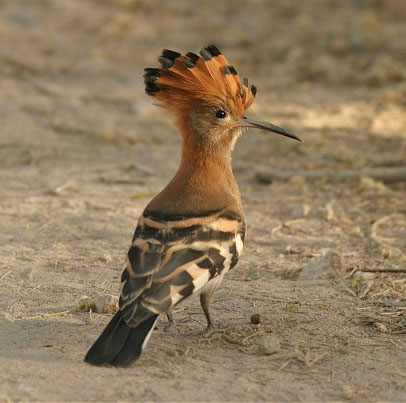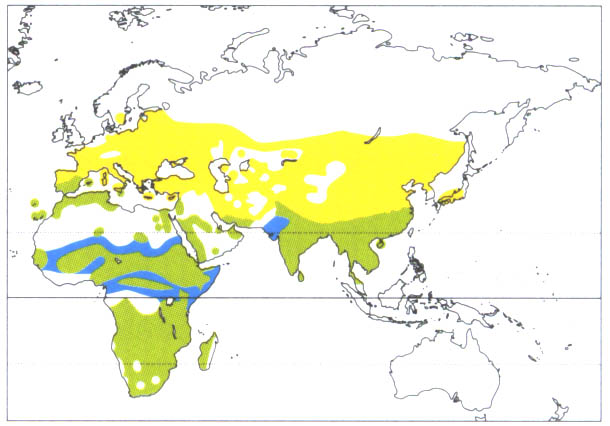 Coraciiformes Taxon Advisory Group -
Coraciiformes Taxon Advisory Group -
Hoopoe (Upupa epops)
Species Manager: Paul Schutz - Disney's Animal Kingdom
Description
Hoopoes are primarily found in open country such as parks, pastures, orchards,
groves, vineyards, grasslands, and savannah. They require the habitat
to have scattered trees or cliffs for perching and roosting and nesting.
Hoopoes are frequently found around human habitations such as farmlands
and villages. The Madagascar subspecies is commonly found in well-wooded
forest margins and disturbed lowlands.
Status
As a whole the population of hoopoes is not considered to be globally threatened,
with some estimates ranging from 5-10 million birds remaining. Somes subspecies
are declining in number due to habitat disturbance and poaching. In Europe,
even though a population estimate of 700,000 breeding pairs remain, the
has been a decline in recent population counts. The hoopoe is listed as
endangered in Germany and vulnerable in many other countries. Previously,
the hoopoe was listed as common throughout the Malay Peninsula and appears
to have declined significantly there, likely due to hunting and disturbance.
 Range
Range
The hoopoe has a wide range and is common in Europe, North and Sub-Saharan Africa, Madagascar and Asia.
The most northern populations migrate to tropical regions during the winter months.
The birds populating Africa and southeast Asia are resident in their range.
Habitat
The hoopoe has two basic requirements in its habitat; bare or lightly vegetated ground on which to forage and vertical surfaces with cavities (such as trees, cliffs or even walls, nestboxes, haystacks, and abandoned burrows) in which to nest. These requirements can be provided in a wide range of ecosystems and as a consequence they inhabit a wide range of habitats from heathland, wooded steppes, savannas and grasslands, as well as glades inside forests. The Madagascar subspecies also makes use of more dense primary forest. The modification of natural habitats by humans for various agricultural purposes has led to them becoming common in olive groves, orchards, vineyards, parkland and farmland, although they are less common and declining in intensively farmed areas. Hunting is of concern in southern Europe and Asia.
Behavior
Migration
Migratory in northern parts of range, partially migratory to resident elsewhere. Nominate epops, breeding in all west Palearctic except Egypt and southern Algeria, winters in small numbers in North Africa and Mediterranean basin, only exceptionally further north. Probably most European migrants winter in Africa south of Sahara, where not distinguishable in the field from local senegalensis. Migration (much of which nocturnal) occurs on broad front across Europe and Mediterranean, and probably across Sahara also.
Migration seasons notably protracted. Autumn dispersal spans mid-July to late October or even into November; normal termination period masked by overwintering in southern breeding areas. Begin arriving south of Sahara in second half of August, with main arrivals there September-October. Return movement detected from early February in Morocco and Malta; at peak mid-March to April, tailing off during May. In Britain and Ireland, recorded in every month but chiefly in spring, with marked peak April-May; autumn records peak September; spring records involve overshooting in anticyclonic weather and arrivals in overcast conditions with fronts moving into English Channel and North Sea.
Individuals of the dark east Palearctic race saturata apparently occur regularly in Sweden in autumn, perhaps as a result of reversed migration, some remaining through winter.
Vocalizations
Each phrase in the distinctive and melodic hoopoe vocalization is comprised
of between two and five notes, with a short pause separating multiple
phrases. These phrases are routinely grouped together to form sentences
which may be separated by several seconds themselves.
The
song is typically delivered from an elevated perch such as a canopy-level
branch, rooftop, or powerline. While delivering the vocalization, the
hoopoe will typically point his head downward in order to increase the
volume of air in the passages, allowing the neck to inflate and pulse
to intensify the sounds.
There
is a significant difference in the vocalization of the hoopoe found in
Madagascar that has led for some calls to separate Upupa e. marginata into it's own species. This hoopoe vocalizes using a soft, rolling purr
repeating at regular intervals. This call is typical of feeding calls
of the remainder of hoopoe species.
An example of the hoopoe vocalization can be heard by clicking here.
Reproduction
The Hoopoe is monogamous, although the pair bond apparently only lasts for a single season. They are also territorial, with the male calling frequently to advertise his ownership of the territory. Chases and fights between rival males (and sometimes females) are common and can be brutal. Birds will try to stab rivals with their bills, and individuals are occasionally blinded in fights. The nest is in a hole in a tree or wall, with a narrow entrance; it may be unlined or various scraps may be collected. The female alone is responsible for incubating the eggs. Clutch size varies with location, with northern hemisphere birds laying more eggs than those in the southern hemisphere and birds in higher latitudes having larger clutches than those closer to the equator. In central and northern Europe and Asia the clutch size is around 12, whereas it is between four in the tropics and seven in the subtropics. The eggs are round and milky blue on laying but quickly discolour in the increasingly dirty nest. They weigh 4.5 grams. A replacement clutch is possible if the first breeding attempt is unsuccessful.
The Hoopoes have well-developed anti-predators defences in the nest. The uropygial gland of the incubating and brooding female is quickly modified to produce a foul-smelling liquid, and the glands of nestlings do so as well. These secretions are rubbed into the plumage. The secretion, which smells like rotting meat, is thought to help deter predators, as well as deter parasites and possibly act as an antibacterial agent. The secretions stop soon before the young leave the nest. In addition to this secretion nestlings are able to direct streams of faeces at nest intruders from the age of six days, and will also hiss at intruders in a snake like fashion. The young also strike with their bill or with one wing.
The incubation period for the species is between 15 and 18 days. During incubation the female is fed by the male. The incubation period begins as soon as the first egg is laid, so the chicks are born asynchronously. The chicks hatch with a covering of downy feathers, by around day days feather quills emerge which become adult feathers. The chicks are brooded by the female for between 9 to 14 days. The female later joins the male in the task of bringing food. The young fledge in 26 to 29 days and remain with the parents for about a week.
Captive
breeding information for hoopoes can be found in this paper, Breeding the Hoopoe (Upupa epops) at Disney's Animal Kingdom, written
by Paul Schutz, Zoological Manager of Birds at Disney's Animal Kingdom.
Diet
The
diet consists primarly of large insects and insect larvae and pupae. The
prey size is typically smaller than the length of the bill. Insect prey
items may include mole crickets, beetles, caterpillars, spiders, termites,
ants, locusts, ant-lions, grasshoppers, and centipedes. Hoopoes will also
rarely consume small vertebrates such as lizards, snakes, frogs, and geckos.
They usually forage alone or in pairs on the ground, digging probing with
their long bill in the soft ground. They also are routinely observed overturning
leaves and other small debris in search of food.
Hoopoe
Bibliography



